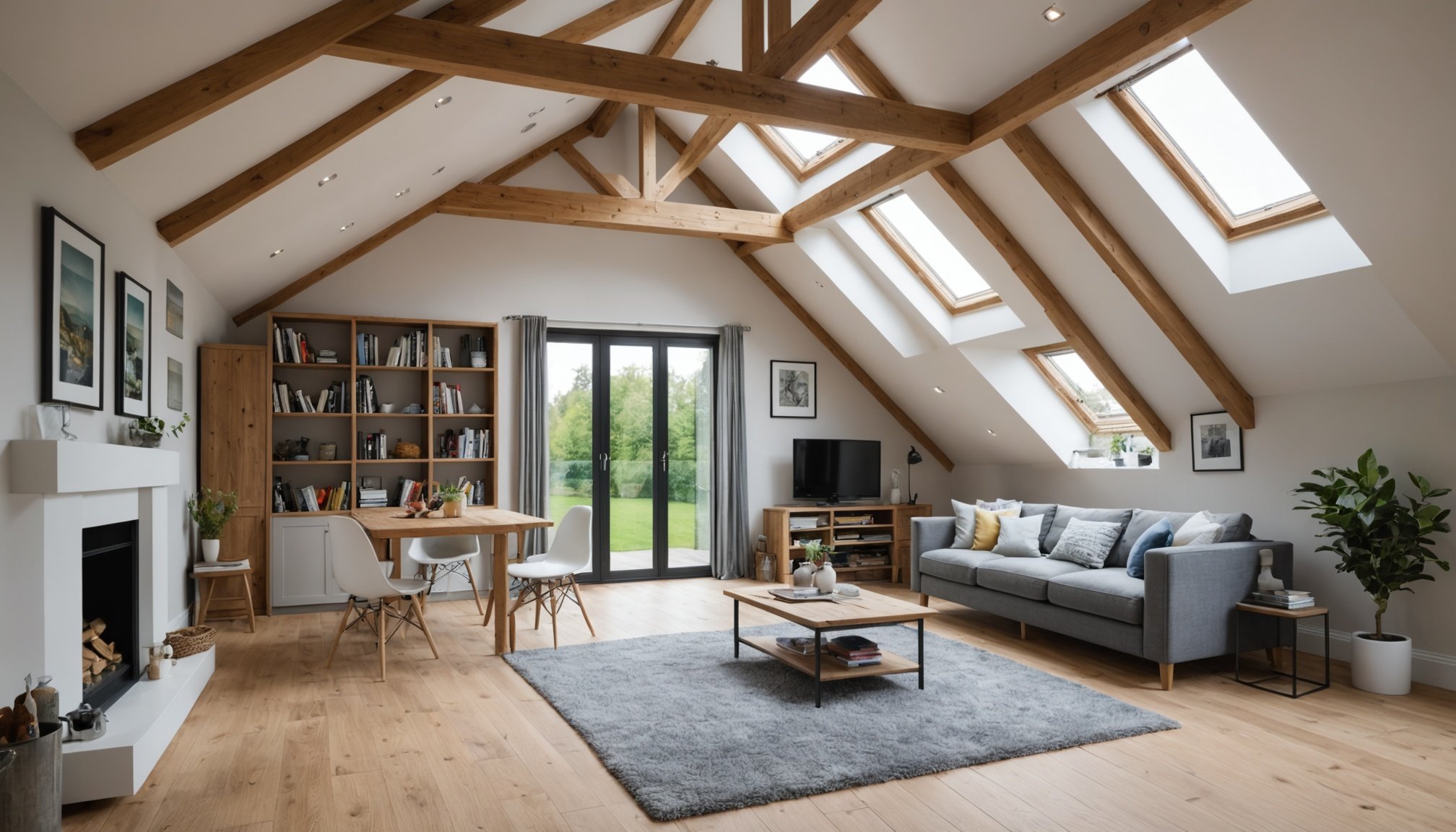Planning Permissions for Mezzanine Levels
Planning permissions are a crucial aspect of any construction project, especially when dealing with loft conversions to incorporate a mezzanine level. In the UK, building codes and loft conversion regulations establish specific requirements to ensure safety and structural integrity. It’s vital to understand that adding a mezzanine may necessitate obtaining specific permits.
When considering a loft conversion, consulting with local authorities early in the process is imperative. They provide guidance on whether you require planning permissions for your specific design. Factors such as the height of the loft, existing structures, and potential changes to the property’s exterior can influence the need for permissions.
Also to read : Transform Your UK Mid-Century Modern Home with the Ultimate Smart Lighting Setup
Moreover, UK building codes address aspects like fire safety, access, and ventilation, which are essential when planning a mezzanine. Working within these parameters ensures compliance and minimizes potential issues post-conversion.
Understanding loft conversion regulations can be complex, but the importance of adhering to these should not be underestimated. Engaging with professionals familiar with building codes and planning permissions can streamline the process. It reinforces the balance between creativity in design and adherence to legal requirements, ultimately leading to a successful and compliant mezzanine addition.
Also to read : Create a magical reading space with unique book nooks
Structural Requirements
Ensuring structural integrity is crucial when planning a mezzanine for a loft conversion. An initial assessment of the existing structures is essential to confirm they can support additional weight. It’s important to understand that lofts should meet specific load-bearing capacities to safely accommodate a mezzanine. A professional inspection can identify whether structural reinforcement is needed and recommend the necessary modifications.
When discussing loft conversion design, selecting robust materials is imperative. Recommended materials like steel or reinforced wood are often chosen to guarantee safety and durability. These materials not only support the structure but also contribute to a more stable and secure space. Ensuring compliance with structural guidelines prevents potential hazards and supports sound architectural practices.
Incorporating a mezzanine demands careful attention to load-bearing requirements. This aspect includes calculating the weight distribution and accounting for the intended use of the space. Meticulous planning of the design ensures that the combination of aesthetics and functionality aligns with the necessary structural standards. Experts in structural engineering can offer indispensable guidance to preserve the integrity of your project. Engaging professionals with expertise in loft conversion design ensures a successful and safe integration of the mezzanine level.
Design Inspiration and Ideas
Exploring mezzanine design opens doors to innovative concepts that maximise space and enhance aesthetics. Incorporating a mezzanine in a loft presents a unique opportunity to creatively optimise space without compromising on style. Mezzanine levels can offer additional living or working spaces by utilising vertical dimensions effectively.
Successful examples of contemporary loft conversions include mezzanines that seamlessly integrate into the home’s design. Consider elevating the bed to free up floor space, or creating a cosy reading nook suspended above the living area. These ideas reflect a balance between functionality and charm, making the most of every inch available.
To further embellish a mezzanine, focusing on natural light and airflow is vital. Design elements like large windows or skylights can flood the area with light, amplifying the sense of openness. Installing railings instead of solid partitions allows air to circulate freely, enhancing comfort.
When envisioning a mezzanine design, start with a clear understanding of your goals for the space and how it complements your existing loft. Such imaginative approaches foster an environment that’s both practical and visually appealing, offering inspiration for a successful and harmonious integration of the mezzanine level.
Materials and Finishes
Selecting the right construction materials is pivotal in ensuring the durability and elegance of a mezzanine level. One prominent choice for mezzanine flooring is plywood, celebrated for its robustness and cost-effectiveness. Alternatively, engineered wood offers aesthetic appeal and strength, though it may be pricier.
When discussing interior finishes, consider options that complement the loft’s overall style. Paint or wallpaper might lend a modern air, while natural wood panelling could bring warmth and texture to the space. If aiming for an industrial look, exposed metal beams might serve both structural and decorative purposes, enhancing the loft’s character.
Quality materials can sometimes demand a higher budget, yet they assure sustainability and satisfaction over time. It is crucial to weigh cost versus quality: opting for cheaper materials might incur additional costs for maintenance. When planning your mezzanine construction, delineate a clear budget to avoid unforeseen expenses and ensure quality isn’t compromised. Engaging with suppliers who offer quality assurance and warranty could significantly mitigate future risks. This thoughtful selection of materials and finishes aids in achieving a harmonious balance between aesthetics and functionality, ensuring your mezzanine level stands the test of time.
Cost Implications
Adding a mezzanine to your loft requires careful financial planning. Understanding the potential costs involved is crucial for a successful project. Several factors influence the total cost, including the complexity of the design, materials chosen, and labour costs.
For a typical loft conversion with a mezzanine, you might consider these financial aspects:
-
Design and Planning Fees: Initial consultation fees with architects and designers are essential. Their expertise ensures adherence to regulations.
-
Materials and Finishes: Quality materials like engineered wood can vary in price. Prioritise durability to avoid future expenses.
-
Labour Costs: Hiring skilled contractors is vital for structural safety. Labour fees can depend on project intricacies and time duration.
When budgeting, allocate additional funds for unexpected costs. Prices can fluctuate based on location and market conditions. To manage these variables, set a realistic budget, and prioritise the essentials without compromising on quality.
Effective budgeting involves detailed cost estimations and regular financial reviews. It’s also wise to consult professionals for tailored advice, ensuring your mezzanine project aligns with both your vision and budget. By navigating the cost implications strategically, you can enjoy a seamless loft conversion experience without financial strain.
Professional Services Involved
Integrating a mezzanine into a loft conversion is a complex task requiring the expertise of various professionals. Engaging qualified individuals ensures that the project meets all regulatory and aesthetic requirements. Among the essential roles are those of architects and structural engineers. Architects create functional designs that make optimal use of the available space while adhering to building standards. These experts are crucial in developing a seamless and integrated design.
Structural engineers play a pivotal role in assessing and ensuring the load-bearing capabilities necessary for a mezzanine level. Their evaluations determine if existing structures are sufficient or need reinforcement. This assessment is integral for maintaining structural integrity and preventing future issues.
Hiring professional contractors with proven experience in loft conversions is vital. Reliable contractors execute the project according to design specifications and manage on-site logistics. It’s important to research and select reputable professionals to avoid common pitfalls associated with inexperienced builders.
In summary, the involvement of skilled professionals cannot be overstated. By thoughtfully assembling a team equipped with the right expertise, you ensure a successful, compliant, and aesthetically pleasing loft conversion. Through their combined efforts, your vision for a functional and elegant mezzanine in your loft can be realised.
Practical Steps for Integration
Integrating a mezzanine into your loft conversion involves a series of organised steps. Firstly, establish a clear project management plan. This guide should outline each phase, ensuring you effectively navigate the complex loft conversion process.
Begin by conducting a comprehensive assessment of the existing structures. This informs your step-by-step guide, preventing unforeseen structural issues. Collaborate closely with designers, ensuring your vision aligns with technical realities and regulations.
Next, obtain necessary planning permissions, addressing restrictions by consulting local authorities. Checklists simplify the workflow; detail tasks for each stage, from initial design to final touches.
Coordination between contractors and designers is crucial. Set regular meetings to review progress and adjust plans. This teamwork ensures that all elements seamlessly align, from the aesthetics to the legal requisites. An organised approach minimises risks and keeps the project on schedule.
Finally, embrace flexibility. Successful loft conversions often require adapting to challenges; a well-structured management plan accommodates changes without significantly derailing the timeline or budget. By meticulously following these steps, your loft conversion process becomes an efficient and fulfilling project, transforming ideas into reality.
Case Studies and Visual Aids
Exploring real-life case studies offers valuable insights into the successful creation of mezzanine levels in loft conversions. These detailed examples illustrate how various design elements can come together to create a functional and aesthetically pleasing space. By examining such successful conversions, you gain a clearer understanding of how to tackle your own project.
Visual guidance plays a crucial role in the planning and execution process. Diagrams, sketches, and 3D models help conceptualise design ideas, offering a tangible representation of potential outcomes. This approach not only aids in visualising the final look but also assists in communicating concepts with architects and builders.
Consideration of successful conversions provides practical lessons, highlighting challenges and solutions encountered during implementation. For instance, a case study may reveal how light was maximised through strategic window placement or how structural obstacles were overcome with creative design solutions.
Incorporating visual aids like before-and-after photos can inspire creativity and confidence in your project’s potential. Such resources are invaluable for refining your vision and ensuring all elements align with your intended results. By learning from past projects, you harness tried-and-tested strategies to inform your loft conversion plan, encouraging a smooth and successful transformation.











